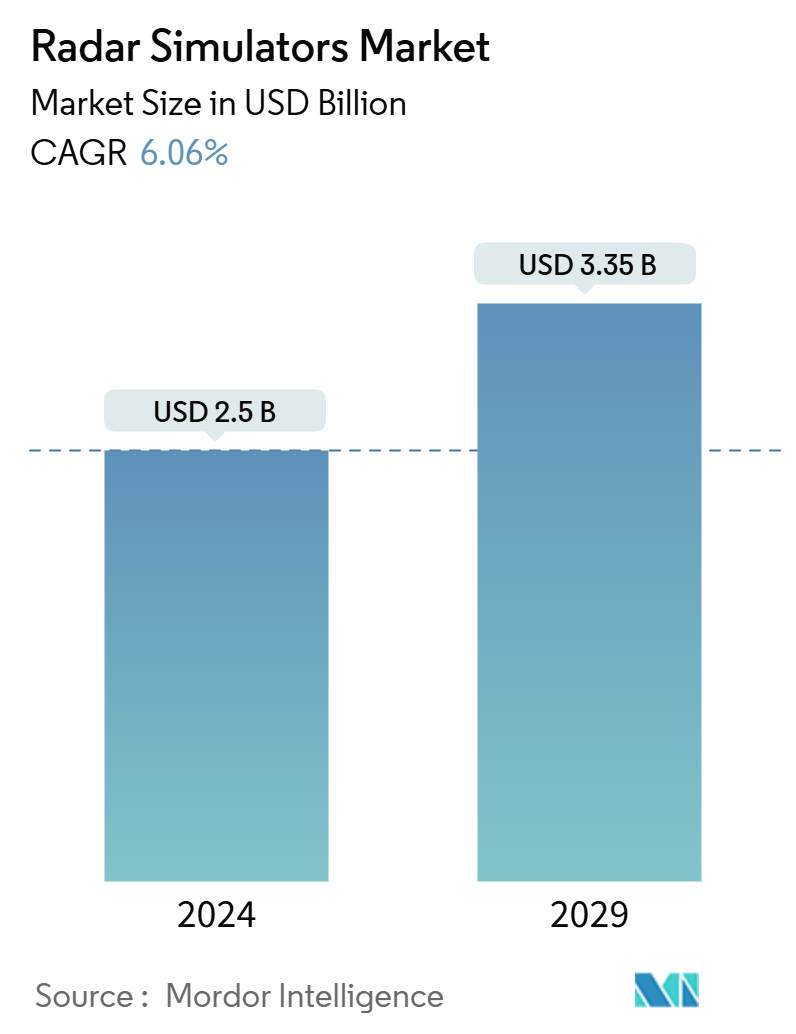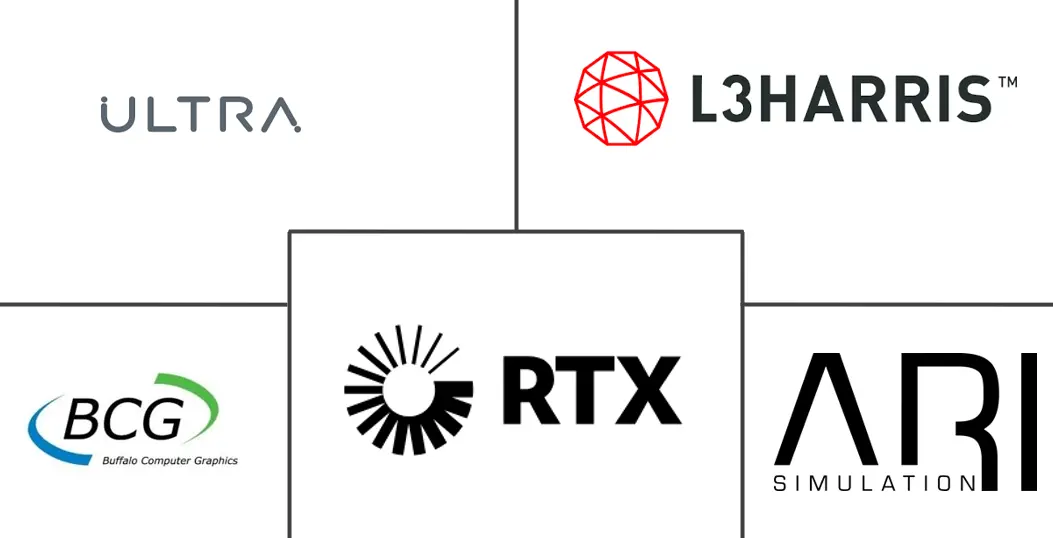Market Size of Radar Simulators Industry

| Study Period | 2019 - 2029 |
| Market Size (2024) | USD 2.5 Billion |
| Market Size (2029) | USD 3.35 Billion |
| CAGR (2024 - 2029) | 6.06 % |
| Fastest Growing Market | Asia Pacific |
| Largest Market | North America |
| Market Concentration | High |
Major Players
*Disclaimer: Major Players sorted in no particular order |
Radar Simulators Market Analysis
The Radar Simulators Market size is estimated at USD 2.5 billion in 2024, and is expected to reach USD 3.35 billion by 2029, at a CAGR of 6.06% during the forecast period (2024-2029).
A radar simulator emulates various radar profiles to provide users with an appropriate environment for training or performing functional tests on a system. The system comprises both hardware and software components.
The emergence of modern warfare systems, such as electronic warfare (EW) and network-centric warfare (NCW), has bolstered the use of radars in military operations, thereby driving the demand for radar simulators for training military personnel.
The increasing emphasis on military ground clearance operations predominantly fuels the rising demand for radar simulators. With terrorists increasingly turning to UAVs to target civilians and critical infrastructure, air force authorities, homeland security groups, and defense forces are facing a mounting challenge. Consequently, governments worldwide prioritize deploying radar simulators to train their police and internal security forces. However, rapid technological evolution in the field of microelectronics renders a financial burden on the market players as the players cannot capitalize and recover their R&D costs.
Different types of radar simulators are being configured with multiple technologies to address emerging threats. This has fostered the integration of modular architecture design for radar simulators.
Radar Simulators Industry Segmentation
The market study encompasses a radar simulator's hardware and software components. A software-based radar system generates simulated radar video data by combining tracks, AIS, navigation, and secondary radar data. The radar simulator can create moving targets through integrated graphical tools to simulate real-time scenarios for trainers and system testers to use. The hardware segment considers components, such as antenna, transmitters, receivers, waveform generators, and microcontrollers, used to create a physical setup of the radar simulator.
The radar simulators market is segmented by component, application, and geography. By component, the market is segmented into hardware and software. By application, the market is segmented into commercial and military. The report also covers the market sizes and forecasts for the radar simulators market across different regions. For each segment, the market size is provided in terms of value (USD).
| Component | |
| Hardware | |
| Software |
| Application | |
| Commercial | |
| Military |
| Geography | |
| North America | |
| Europe | |
| Asia-Pacific | |
| Latin America | |
| Middle East and Africa |
Radar Simulators Market Size Summary
The radar simulators market is experiencing steady growth, driven by the increasing demand for advanced training and testing systems in both military and commercial sectors. The integration of modern warfare systems, such as electronic and network-centric warfare, has heightened the need for radar simulators to train military personnel effectively. In the commercial aviation sector, the rebound in air passenger traffic post-COVID-19 has led to significant investments in airport infrastructure, necessitating the training of air traffic control personnel using radar simulators. This demand is further fueled by the proliferation of new air routes and radar technologies, particularly in the Asia-Pacific region, where robust economic growth and increasing air traffic are driving the need for advanced radar systems.
The market is characterized by intense competition among a few dominant global vendors, who are striving to maintain their market share through innovation and strategic investments in research and development. Companies like Mercury Systems Inc., L3Harris Technologies Inc., and Raytheon Technologies Corporation are key players, competing on the basis of their manufacturing capabilities, global presence, and product offerings. Despite the competitive landscape, the market faces challenges related to the modularity of radar simulator designs, which integrate multiple features into a single platform. However, the ongoing advancements in radar technology and the increasing demand for sophisticated training systems are expected to sustain the market's growth trajectory.
Radar Simulators Market Size - Table of Contents
-
1. MARKET DYNAMICS
-
1.1 Market Overview
-
1.2 Market Drivers
-
1.3 Market Restraints
-
1.4 Industry Attractiveness - Porter's Five Forces Analysis
-
1.4.1 Threat of New Entrants
-
1.4.2 Bargaining Power of Buyers/Consumers
-
1.4.3 Bargaining Power of Suppliers
-
1.4.4 Threat of Substitute Products
-
1.4.5 Intensity of Competitive Rivalry
-
-
-
2. MARKET SEGMENTATION
-
2.1 Component
-
2.1.1 Hardware
-
2.1.2 Software
-
-
2.2 Application
-
2.2.1 Commercial
-
2.2.2 Military
-
-
2.3 Geography
-
2.3.1 North America
-
2.3.2 Europe
-
2.3.3 Asia-Pacific
-
2.3.4 Latin America
-
2.3.5 Middle East and Africa
-
-
Radar Simulators Market Size FAQs
How big is the Radar Simulators Market?
The Radar Simulators Market size is expected to reach USD 2.5 billion in 2024 and grow at a CAGR of 6.06% to reach USD 3.35 billion by 2029.
What is the current Radar Simulators Market size?
In 2024, the Radar Simulators Market size is expected to reach USD 2.5 billion.

